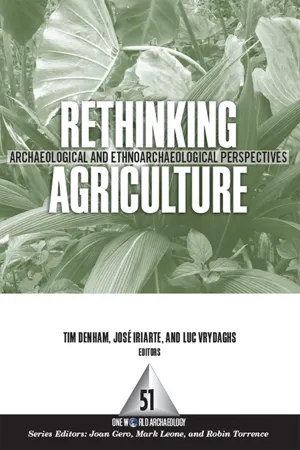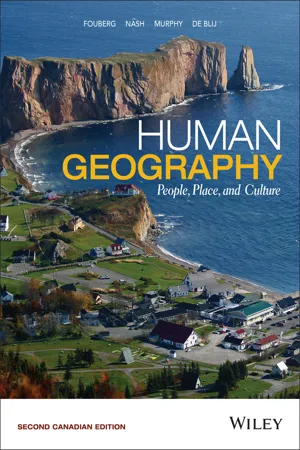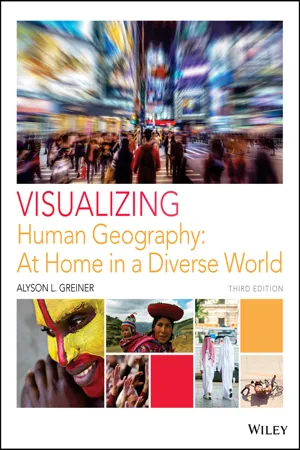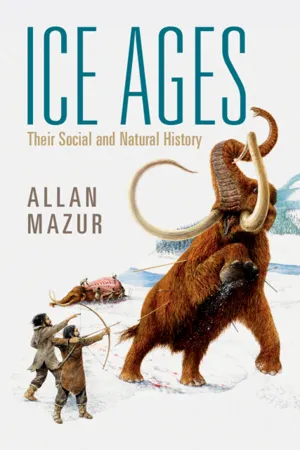Geography
Agricultural Hearths
Agricultural hearths refer to regions where early farming practices and domestication of plants and animals first originated. These areas are considered the birthplaces of agriculture and have had a significant impact on the development of human societies and civilizations. The concept of agricultural hearths helps to understand the spread of agricultural techniques and the diffusion of crops and livestock around the world.
Written by Perlego with AI-assistance
Related key terms
1 of 5
4 Key excerpts on "Agricultural Hearths"
- eBook - ePub
Rethinking Agriculture
Archaeological and Ethnoarchaeological Perspectives
- Timothy P Denham, José Iriarte, Luc Vrydaghs, Timothy P Denham, José Iriarte, Luc Vrydaghs(Authors)
- 2016(Publication Date)
- Routledge(Publisher)
Increasing acceptance of the concept of multiple areas of local domestication does, however, bring to the fore a related question of process and spatial scale that is of great significance in the prehistory of agriculture: how to identify, among the many local areas of domestication, those from which agricultural systems, with their crops and in some cases domestic animals, spread. The former concept of a small number of primary centres of origin led logically to the assumption that agriculture had spread to the rest of the cultivable world from them, but this view is no longer justified. It needs to be replaced by more refined hypotheses as to why some early agricultural systems spread and others did not.Differences in the capacity of agricultural systems to provide an adequate human diet without substantial reliance on wild food resources is, I suggest, one factor that merits close attention. In a preliminary analysis, I have examined the expansion capacity of several systems by comparing broadly the nutritional status of their assemblages of domesticated plants and animals (Harris 2003). The analysis was based on the idea of ‘core regions’ of early agriculture, as opposed to the traditional concept of a few primary centres where agriculture was believed to have originated independently, and earlier than anywhere else, and from where it was assumed to have spread to most of the rest of the world. The concept of core regions is less deterministic and more responsive to new evidence than that of primary centres. Core regions are identified by synthesising currently available archaeological, palaeoenvironmental, biogeographical, genetic and ethnohistorical data in order to infer where distinctive suites of crops, and in some areas also domestic animals, formed early (but not necessarily the earliest) agricultural systems, some of which spread extensively while others did not. In my preliminary analysis (2003) I only presented evidence from five such regions (western Southwest Asia, central China, Mexico, the Andean highlands and northern tropical Africa), and in so doing I was keenly aware of the inadequacies of the heterogeneous sources of data on which the analysis depended. Finer-scale analysis of more adequate, especially archaeological, data from a larger number of smaller regions is needed to develop and test the hypothesis, but the preliminary exercise I undertook appears to confirm that differences in the nutritional basis of early agricultural systems do correlate with whether or not they spread. The main (here oversimplified) conclusion is that the systems which had the greatest potential to expand territorially into new environments, and to eliminate or absorb preexisting systems of wild-food procurement and production, were those that included cereals and pulses among their staple crops, especially when the crops were combined with livestock raising in systems of agro-pastoral production. - eBook - PDF
Human Geography
People, Place, and Culture
- Erin H. Fouberg, Alexander B. Nash, Alexander B. Murphy, Harm J. de Blij(Authors)
- 2015(Publication Date)
- Wiley(Publisher)
Later, people learned they could generate fire by rapidly rotating a wooden stick in a small hole surrounded by dry tinder. Fire became the focal point of settlements, and the campfire became a symbol of the community. It was a means of making foods digestible and was also used to drive animals into traps or over cliffs. In addition to hunting game on the land, humans harvest- ed shellfish, trapped fish by cutting off small patches of standing water from the open sea, and invented tools such as harpoons for spearing large fish, hooks for catching fish, and baskets to capture fish in streams that had fish runs. Using tools and fire, human communities altered their en- vironments, establishing more reliable food supplies by com- bining hunting and fishing with some gathering. They also migrated to take advantage of cyclical movements of fish and animals and to avoid exhausting the supply of edible plants in any one area. THE FIRST AGRICULTURAL REVOLUTION Where did plant domestication begin? Carl Sauer (mentioned in Chapter 8), one of the first geographers to consider this question, believed that the experiments necessary to establish agriculture and settle in one place occurred in “lands of plenty”—that is, in places where there was substantial game and plants for sustenance. Only in such places could people afford to experiment with rais- ing plants or take the time to capture animals and breed them for domestication. As part of a lifetime spent studying cultural origins and diffusion, Sauer closely examined the geography of early agricultural practices, focusing particularly on the location of the agriculture hearths and on the kinds of agricultural in- novations that took place in those hearths. He suggested that Southeast and South Asia may have been the location, more than 14,000 years ago, of the first domestication of tropical plants. - eBook - PDF
Visualizing Human Geography
At Home in a Diverse World
- Alyson L. Greiner(Author)
- 2017(Publication Date)
- Wiley(Publisher)
Agriculture involves the ongoing process of domestication—selecting plants or animals for specific characteristics and influencing their reproduction. Domestica- tion not only makes plants and animals visibly or behaviorally dis- tinct from their wild ancestors, it also increases the interdepen- dence between people and the domesticate. Domestication re- flects human agency. Until very recently, agriculture employed the high- est percentage of people worldwide. Since the 1990s, the percentage of the world’s workforce employed in agri- culture has fallen from 45% to 31%. This decline in the share of agricultural employment is a testament to the ongoing urbanization of our world as well as the mecha- nization and industrialization of agriculture. Even so, employment in the agricultural sector differs vastly from one region and country to another. Although women have been involved in agriculture since it began, certain trends increasingly point to a new feminization of agri- culture (Figure 9.1). Origins of Agriculture Hunting and gathering is the oldest method of obtain- ing food, and historically all people obtained their food this way. Most hunters and gath- erers moved frequently in pursuit of game and seasonally available plants, although some groups that relied heavily on fishing might settle permanently in one location. Strictly speaking, however, hunters and gather- ers are not classified as agriculturalists because they use wild rather than domesticated plants and animals. A geography of employment in agriculture • Figure 9.1 Agricultural employment varies by region and gender. Finbarr O’Reilly/REUTERS agriculture Activi- ties centered on cul- tivating domesticated crops and livestock in order to procure food and fiber for human use or consumption. hunting and gathering Hunting wild animals, fishing, and gathering wild plants for food. - eBook - PDF
Ice Ages
Their Social and Natural History
- Allan Mazur(Author)
- 2022(Publication Date)
- Cambridge University Press(Publisher)
Others in the area lived as nomadic herders, trading their animal products with the settled cultiva- tors, to their mutual benefit. The agrarian lifestyle diffused outward, eventually across the inhabited world. Agriculture and permanent settle- ment were like chicken and egg, impossible to tell which came first because each required the other. The “Fertile Crescent” was the center of attention, a name popularized in the early twentieth century by archeologist James Breasted (1916), referring to an arch of elevated land from the eastern Mediterranean coast (the Levant), eastward through Syria and Turkey, and down into today’s Iraq and the Zagros flanks in Iran, toward the Persian Gulf. Most of it was fertile and well-watered compared to neighboring mountains or the Arabian desert (Figure 13.1). Teaching a university class today, I lecture that becoming agrar- ian – that transition from Paleolithic to Neolithic – was one of the two most significant transformations in human history. (The other was the industrialization of the last three centuries.) But much I learned as a student is no longer taught because our understanding of this period has changed and no doubt will continue to change with new discoveries, especially in regions not as well studied as the Middle East. The origin of agriculture in the Middle East is still dated to 10,000 years ago, or a little earlier, its oldest-known sites still in the Fertile Crescent. But that is no longer regarded as the sole origination point for agrarian life. There is good evidence of independent agricultural beginnings in central China, the New Guinea highlands, Mesoamerica, the central Andes, the Mississippi basin, western Africa, and southern India, occurring at various times between about 10,000 and 4,000 years ago (Bellwood 2005). Agriculture did not begin once but many times. Furthermore, it now appears that sedentary community life preceded agriculture, at least in the Fertile Crescent.
Index pages curate the most relevant extracts from our library of academic textbooks. They’ve been created using an in-house natural language model (NLM), each adding context and meaning to key research topics.



